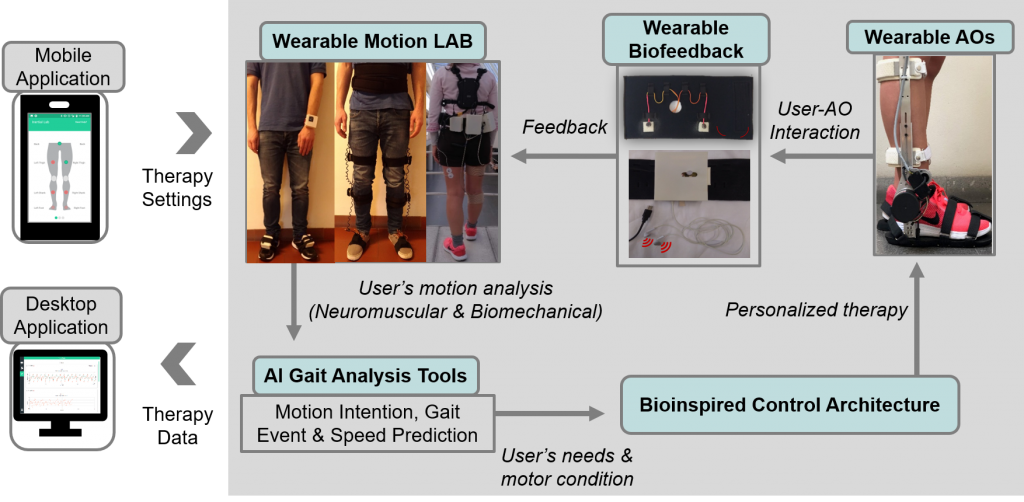Smart, Active Lower Limb Orthotic System





Motivation & Goal
Every year 15 million people suffer a stroke. Stroke is the third leading cause of adult long-term motor disability, compromising the daily living of stroke survivors.
Gait rehabilitation approaching user-oriented and repetitive gait training may evoke brain plasticity, contributing to long-term mobility recovery upon stroke. Active orthoses (AOs) can tackle these rehabilitation abilities while fostering an objective gait monitoring, and open opportunities for encouraging the user’s active participation.
SmartOs aims the development of a smart, wearable active lower limb orthotic system to act as an innovative personalized gait rehabilitation and assistance solution for the robotics-based gait training of stroke survivors.
Approach
This research towards the interoperable, modular, and innovative integration of a Wearable Active Orthosis with a Wearable Motion Lab and a Wearable Biofeedback Systems, following a Bioinspired Control Architecture based on the human motor control system. This combination innovatively followed a user-centered design approach to maximize the user’s acceptability and to foster a reliable and safe gait rehabilitation.
Wearable Motion Lab: aiming real-time, objective user’s motion analysis towards the user’s motor condition diagnosis and the rehabilitation fine-tuning to the patient’s specific needs. It includes small, ergonomic, low-cost, high-precision wearable sensory systems to monitor the biomechanical gait measures (GaitShoe and InertialLAB) and to measure muscle weakness and musculoskeletal status (MuscLAB).
AI-Based Gait Analysis Tools: timely recognition and prediction of the user’s motion intent exploring machine and deep learning algorithms feed by human and environment sensor fusion. This in-depth analysis of the user’s evolution allows adapting the rehabilitation sessions based on objective data, maximizing the efficiency of gait recovery.
Bioinspired Control Architecture: integrates different assist-as-needed assistive control strategies bioinspired on the human motor control system to foster user-oriented assistive commands timely considering the user’s disability level and intention.
Wearable AOs: presents a human-like design to cooperate closely with human beings and are a fully wearable technology aiming both gait rehabilitation and daily assistance.
Wearable Biofeedback System: provides different stimuli to encourage the user’s active participation and maximize treatment intensity; thus, accelerating gait recovery. Moreover, the system ensures real-time feedback adjustment through each rehabilitation session, ensuring that the gait training is performed correctly.
Application Scenarios
Focus groups with clinicians set the SmartOs as a new multi-functional, wearable orthotic assistive system to act in two application scenarios with post-stroke end-users, as follows.
- Provide a personalized gait rehabilitation, and objective motor diagnosis in hospitals, clinical and rehabilitation centers.
- Foster user-oriented gait assistance in daily living, allowing patients to perform their therapy at home, achieving high-level clinical outcomes.
SmartOs is being developed with an adaptive technological character that allows its adjustment, and consequent application into further neurological diseases that affect locomotor ability.
Innovations & Contributions
- User-oriented and repetitive gait training, longer than the manual therapists’ assistance, to enhance motor relearning and motor coordination.
- Assist-as-needed gait training with variable challenging therapy according to the user’s needs to recover functional motor ability.
- High-challenging motor therapies, contributing to a high-level of muscle strengthening.
- Objective and reliable assessment of the user’s motor condition to support clinical diagnostic.
- AI-based gait analysis tools to support the clinical decision for a more informed prescription of physical rehabilitation therapy.
- Encourage the user’s participation in the therapy; thus, accelerating the motor recovery.
- Modular assistive solution, allowing the selection of the most indicate system according to the end-users needs while reducing healthcare costs.
- Technological scalability that allows extending the SmartOs’ clinical perspectives for novel therapeutic goals.
Grants
This project is funded by FEDER Funds through the Programa Operacional Regional do Norte and national funds from FCT with the project SmartOs –Controlo Inteligente de um Sistema Ortótico Ativo e Autónomo-under Grant NORTE-01-0145-FEDER-030386.





